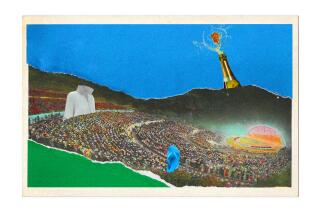Bowling Alley May Fade Into Memory : Sports: Corbin Bowl could reopen if quake repairs are made. Other lanes also face problems.
- Share via
Tuesday was the day to pick up a pink bowling ball at the Corbin Bowl, a San Fernando Valley landmark and movie industry hangout since the Eisenhower era, which suffered structural damage in the Jan. 17 earthquake.
With the future of the bowling alley on Ventura Boulevard in Tarzana uncertain, its operator, Allen Shaw, took leave of the business for good Tuesday, giving employees farewell hugs and auctioning off the 1950s-era jukeboxes, pink bowling balls and light fixtures he has collected since he leased the place in 1978.
Shaw said he was unable to reach agreement with the building’s owner on the higher rent the owner says is needed to pay for $250,000 in repairs.
His departure exemplified problems affecting local bowling alleys, strained by the triple threat of earthquake damage, rising real estate values and what some say is a decline in interest in the sport.
The Corbin Bowl opened in 1959. Over the years, it was used as a set for television shows, including episodes of “Quincy” and “Moonlighting,” and was popular for cast parties, Shaw said.
The business has always been a good one, he said. But after the structure sagged in the quake, he was unable to negotiate a new lease with the building’s owner, Jack Calig, who said Shaw’s rent was too low, even before the need for repairs.
Shaw said he is heading for Hawaii to begin again.
Calig said he hopes to get the building repaired and reopened for bowling by summer, but added that if he gets a good offer to sell the property, the lanes may close for good.
If that happens, the Corbin Bowl will become one of many bowling alleys in the region that have faded into memory.
In the past decade, scores of bowling lanes have been lost in the San Fernando Valley as establishments in Encino, Panorama City and elsewhere shut down, Calig said. Industry experts say the problem is that bowling is a comparatively low-rent enterprise easily nudged out by more profitable retail businesses.
“People think bowling alleys make a lot of money, but it’s a high-expense industry,” said Warren Flanigan, regional vice president of Brunswick Recreation Centers, a bowling center chain. “Per square foot, a grocery store is worth much more.”
The earthquake was another blow to bowling. The temblor damaged most of the 13 bowling centers in the San Fernando, Simi and Santa Clarita valleys, and resulted in the temporary closure of five.
Tom Christi, general manager of The Sports Center in Studio City, who came to watch the bidding on Corbin Bowl artifacts, estimated that the earthquake deprived about 5,000 league bowlers of their usual haunts.
“Half of those people will stop bowling,” he predicted glumly.
There are signs that the number of bowlers was already in decline before the quake.
Both the San Fernando Valley Women’s Bowling Assn. and the Los Angeles Bowling Assn., which has mostly male members, report dwindling membership numbers in recent years, followed by an especially sharp dive after the earthquake.
“People can’t afford it, or their children have other activities,” said Charlene Eton, secretary of the women’s association, which is down to about 7,000 members, a drop of 1,000 since last year.
Flanigan of Brunswick said bowling industry leaders have struggled for years with the question of how to revive their industry as a staple of middle-class entertainment.
Their soul-searching has produced the newest image-revision for the sport: No longer are their businesses “bowling alleys.”
“It’s got a very negative connotation,” Flanigan said. “Ask someone what a bowling alley is and they will say it’s dark and dingy, with people spitting on the floors.”
“Bowling center”--or better yet, the prim “recreation/entertainment center”--are now preferred, said Shaw of the Corbin Bowl. Bowling company executives hope the promise of better lighting, less smoking and a more family oriented atmosphere will help keep the sport on its feet.
Calig said he still has high hopes he can restore the Corbin Bowl facility for use as a bowling center.
The building is for lease, and a new bowling alley operator might be able to move in by June, Calig said. He is even considering operating the bowling alley himself, perhaps employing a Las Vegas-style decor.
Meanwhile, other bowling alley owners managed to clean out the remains of Shaw’s business.
In brisk succession, the auctioneer sold the Wurlitzer jukebox for $3,000, a 1950s-era Coke machine for $950 and a gasoline pump for $900.
The sale saddened some bowlers, though 1950s nostalgia didn’t seem to be the reason.
Rather, Eton of the women’s association said she would miss the unique lane surface at the Corbin Bowl.
“I enjoyed the people that worked there, I will miss them,” she added.
More to Read
Go beyond the scoreboard
Get the latest on L.A.'s teams in the daily Sports Report newsletter.
You may occasionally receive promotional content from the Los Angeles Times.










